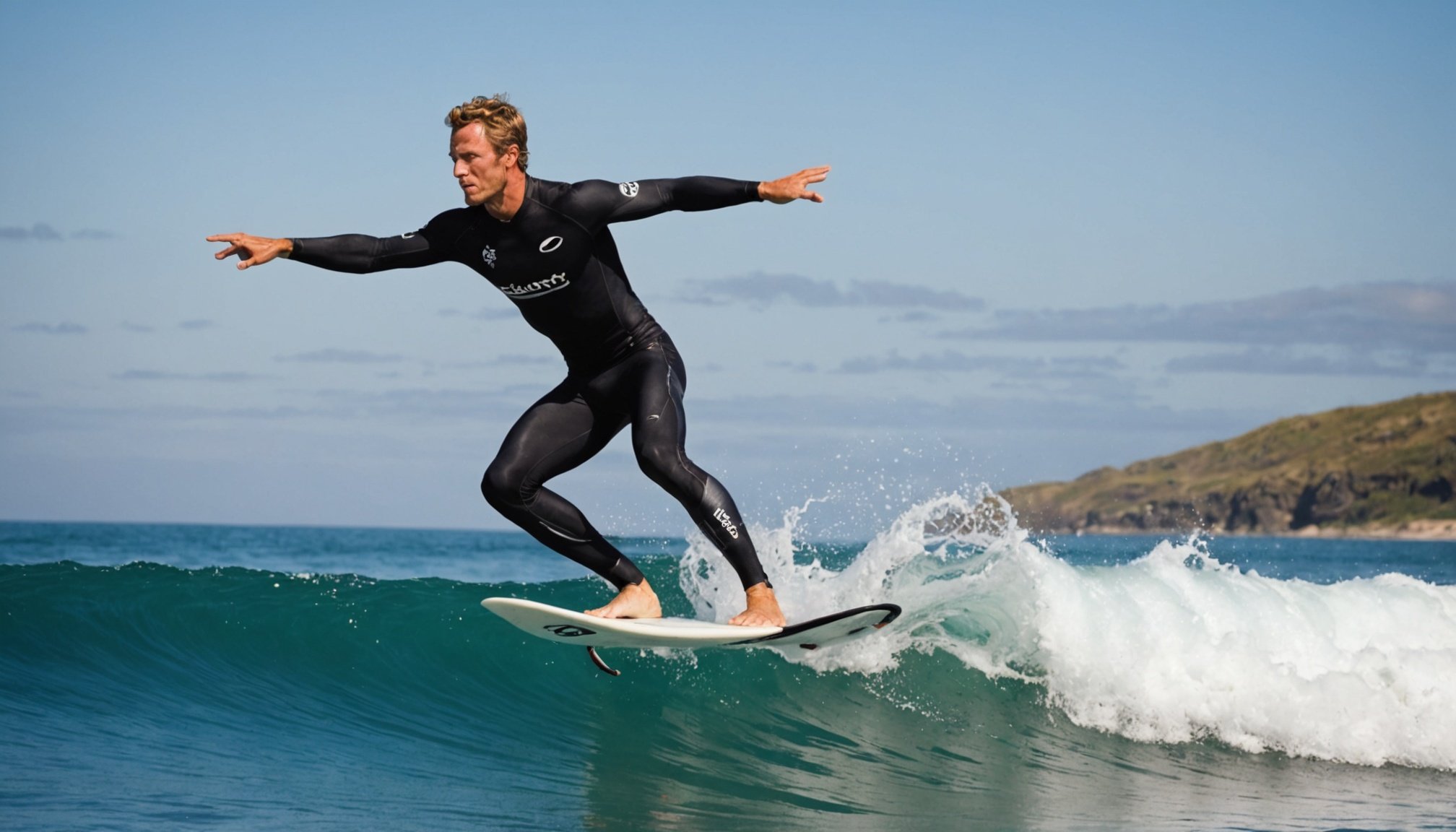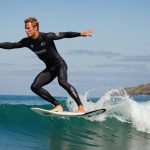Importance of Balance in Surfing
Balance is integral to surfing as it underpins elite surfer performance. For those mastering waves or novices just starting, maintaining balance is crucial. It directly influences how smoothly and efficiently surfers can execute manoeuvres.
Balance in surfing helps in performing turns and tricks. A surfer’s ability to shift their weight and adjust their position on the board determines their capability to respond to the wave’s motion. It allows surfers to make precise and agile moves, keeping them stable and in control while riding a wave’s crest or navigating its troughs.
Also to discover : Mastering the art of spins: elevate your ice skating with targeted strength training strategies
Furthermore, balance significantly impacts stability, enhancing a surfer’s connection with their board. The importance of stability cannot be understated, as it can be the difference between riding a wave and wiping out. Sustained balance contributes to injury prevention because unequal distribution of weight can lead to falls and potential harm.
As skills progress, the importance of balance becomes evident in the longevity of a surfer’s career. By focusing on maintaining balance and developing stability, surfers not only enhance their performance but also minimise risks, ensuring they enjoy the sport for many years.
In parallel : Elevate your cricket game: unleashing ultimate fielding agility with expert strategies
Advanced Techniques for Improving Balance
Mastering balance techniques for surfers is crucial, especially for those scaling the heights of elite surfing. Elite surfing exercises focus intensely on improving aspects like proprioception and core strength, vital for maintaining steadiness and agility on a board.
Proprioception refers to the body’s ability to sense its position and movement, a skill that can be honed through specific drills. Balance boards or wobble boards are commonly used to develop this sense, as they mimic the unstable conditions of a surfboard on water. Engaging in these balance drills helps surfers respond more intuitively to waves, enhancing their dynamic balance.
When it comes to core strength, exercises such as plank variations and rotating side planks are excellent. These workouts target key muscle groups that stabilise the body, ensuring surfers can effectively hold their posture under varying wave conditions.
To further challenge this dynamic balance, surfers incorporate unstable surfaces into their training. For instance, performing squats on a Bosu ball or single-leg stands on a foam mat push their balance skills to the limit.
In summary, a structured combination of drills and exercises greatly enhances the ability of surfers to perform with agility and precision.
Exercises Tailored for Elite Surfers
To ride the waves like a pro, elite surfers must focus on personalised surfing exercises that enhance their core stability and balance. This comprehensive approach ensures that surfers maintain peak performance.
Plyometric Training
Plyometric exercises are essential for surfers who wish to boost their explosive balance. These exercises, such as jump squats and box jumps, focus on developing fast, powerful movements by stretching and contracting muscles quickly. The goal here is not just strength but also the agility to make those quick, decisive movements on your board. Improving these aspects can significantly enhance your surfing capabilities, making you more reactive and flexible during dynamic wave conditions.
Stability Board Drills
Stability board drills are an excellent way to hone one’s balance in real-time. These exercises simulate the unstable conditions experienced while surfing. Using a balance board, surfers perform various drills to improve their equilibrium and body control. This practical training prepares athletes for the unpredictability of the ocean, ensuring they stay grounded and composed on their surfboard.
Yoga and Flexibility
Yoga plays a pivotal role in enhancing flexibility and balance for surfers. Through routines focused on stretching and balance, surfers can increase their range of motion and muscle flexibility. This flexibility is crucial in maintaining balance while manoeuvring through waves, and it also aids in preventing injuries.
Integrating Balance Strategies into Training Routines
Incorporating balance integration into training routines for surfers can significantly enhance performance. Start by introducing simple balance exercises, such as standing on one leg or using a balance board, during warm-ups. Gradually increase the complexity of these exercises as proficiency improves, aligning with the surfer’s skill level and training goals.
Measuring Progress and Adjusting Routines
Regular assessment is key to optimizing performance. Consider using balance tests that track improvements over time. Whether it’s recording how long a balance position is held or monitoring stability on a balance board, measurable progress aids motivation and helps adjust routines effectively. By recognizing improvements or identifying weaknesses, surfers can tailor their training, ensuring constant growth and development.
Personalized Approach
It’s crucial for surfers to have individualized training plans. These should cater to their skill level and address specific challenges they face. Beginner surfers, for instance, may focus more on foundational balance work, while professional athletes might integrate dynamic movements that mimic actual surfing conditions. Customized routines ensure that balance training is not only effective but also sustainable, keeping surfers engaged and motivated in their pursuit of skill enhancement.
Expert Insights and Testimonials
Engaging with insights from surfing experts offers a profound understanding of the sport’s intricacies. Elite surfers often emphasize the necessity of diligent balance training. This balance work is pivotal, as it fine-tunes their performance and response to dynamic and challenging conditions. For instance, renowned surfers have shared that committing to regular balance exercises has significantly enhanced their control during challenging maneuvers.
Professional Feedback and Athlete Testimonials
Professional feedback from athletes frequently highlights the transformative impact of balance-focused routines. Many athletes have testified that it enables them to maintain poise and agility, even amidst the most strenuous conditions. This sentiment is echoed through various first-hand testimonials, where surfers recount their journey towards mastering the elements, illustrating a direct correlation between dedicated balance training and peak performance.
Expert Recommendations
Experts recommend incorporating balance training into daily practice, underscoring its role in achieving seamless surfing experience. They suggest starting with simple exercises and progressively incorporating more complex techniques. This gradual approach can help surfers adapt and thrive in changing ocean conditions, ensuring their skills are not only maintained but continuously enhanced. Such recommendations are vital for amateurs striving to elevate their skills and professionals seeking to refine their competitive edge.
Performance Benefits of Enhanced Balance
Balance training plays a critical role in performance enhancement for surfers, delivering substantial benefits in agility and skill on the waves. By focusing on balanced movements, surfers can notably improve their performance metrics, allowing for more precise and controlled maneuvers.
Enhanced Performance Metrics
Balance training is linked directly to agility in surfing, as it enables surfers to shift weight swiftly and effectively. This agility helps in executing complex maneuvers, leading to higher performance scores during competitions. The coordination gained through balance exercises translates into more fluid rides and quick adaptations to changing wave conditions.
Balance and Agility in Wave Riding
For competitive surfers, balance is not just about standing on a board; it’s about the ability to perform under pressure and in varied sea conditions. Improved balance enhances one’s capacity for dynamic responses, ensuring agility when tackling unexpected wave patterns. This adaptability is crucial for competitive success.
Long-term Benefits
Investing in balance training provides long-term benefits that extend beyond immediate performance gains. It builds intrinsic strength and stability, reducing the risk of injuries over time. Moreover, the continual improvement in balance and agility contributes to sustained excellence in surfing, ensuring surfers remain at the peak of their competitive abilities.
Tools and Aids for Balance Improvement
Utilizing appropriate balance training tools can dramatically enhance surfing performance. Below, we outline some popular tools and technology utilised in training.
Balance Boards
Balance boards are pivotal in surfer training, offering a platform that simulates the unsteady nature of surfing. These tools are highly effective because they demand constant engagement of the core and lower body muscles to maintain stability, which is critical for surfing proficiency. Practicing with balance boards can help surfers improve their lateral balance and reflexes, making transitions on waves smoother and more natural.
Stability Balls
Stability balls engage the core muscles deeply, which is essential for maintaining balance on a surfboard. Training with these balls enhances core strength and stability, translating to improved control when riding waves. Their versatility allows for a range of exercises, from simple seated balances to complex dynamic movements, ensuring a comprehensive balance workout.
Wearable Technology
Emergent wearable technology is shaping the future of balance training by providing real-time feedback on performance. These devices track an individual’s progress through sensors and algorithms, allowing for personalised training adjustments. They monitor balance improvements, ensuring that the surfer can refine techniques effectively and efficiently. Wearables offer insight into balance efficiency that was previously unattainable, making them an invaluable training technology.











